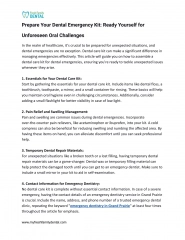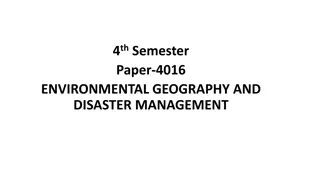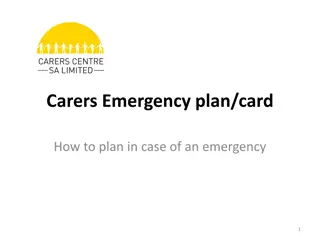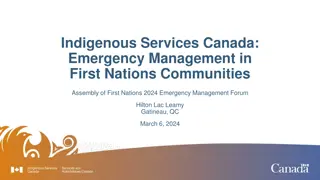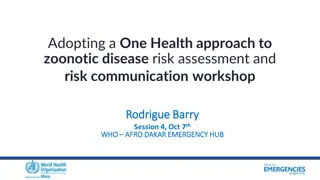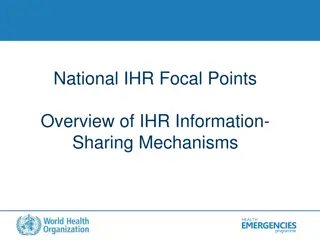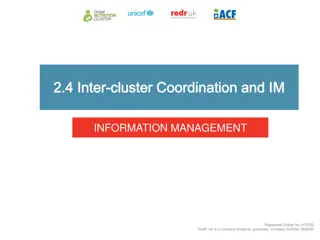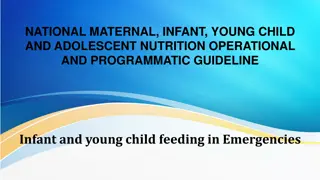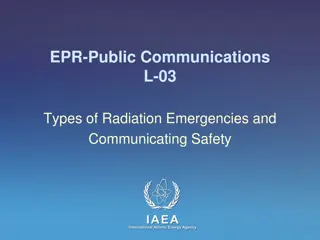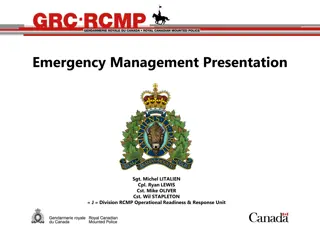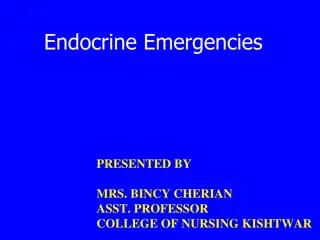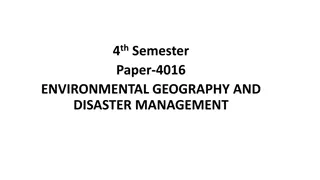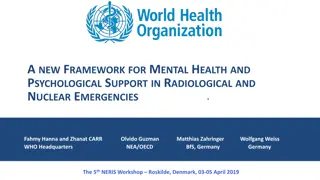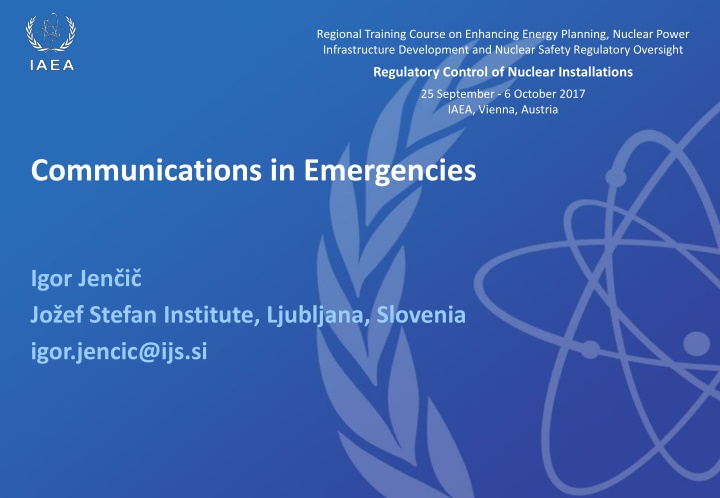
Enhancing Energy Planning and Nuclear Safety Communications Training
Discover the importance of effective public communication in emergencies, understand roles in crisis communication, and learn about the INES scale and emergency planning strategies in the energy and nuclear sectors. Explore the psychological aspects of public behavior during crises and the significance of risk communication.
Download Presentation

Please find below an Image/Link to download the presentation.
The content on the website is provided AS IS for your information and personal use only. It may not be sold, licensed, or shared on other websites without obtaining consent from the author. If you encounter any issues during the download, it is possible that the publisher has removed the file from their server.
You are allowed to download the files provided on this website for personal or commercial use, subject to the condition that they are used lawfully. All files are the property of their respective owners.
The content on the website is provided AS IS for your information and personal use only. It may not be sold, licensed, or shared on other websites without obtaining consent from the author.
E N D
Presentation Transcript
Regional Training Course on Enhancing Energy Planning, Nuclear Power Infrastructure Development and Nuclear Safety Regulatory Oversight Regulatory Control of Nuclear Installations 25 September - 6 October 2017 IAEA, Vienna, Austria Communications in Emergencies Igor Jen i Jo ef Stefan Institute, Ljubljana, Slovenia igor.jencic@ijs.si
Learning objectives To understand the need for planning communication with public in emergency situations. To describe the cycle for organizing and implementing public communication activities. To describe public communication roles of authorities in emergency situations. To understand the purpose of the INES scale. To describe the three areas of impact by which nuclear or radiological events are classified. Communications in Emergencies 25 September - 6 October 2017 2
Contents Planning for public communication in emergencies Organization of emergency communication Roles of authorities INES Communications in Emergencies 25 September - 6 October 2017 3
Introduction Public behaviour during emergencies: can be unpredictable may affect the emergency response Regulators must: be prepared for communication in emergencies understand the psychological roots Riskcommunication Communications in Emergencies 25 September - 6 October 2017 4
Importance of emergency communication Public communication is one of the most important challenges in emergency management. An event may not be considered as an emergency to experts but is perceived very differently by the general public. Communicating effectively with the public about radiation emergencies is key to successful emergency management. (Communication with the Public in a Nuclear or Radiological Emergency, EPR-Public Communications 2012, EPR Series, IAEA, Vienna, 2012) Communications in Emergencies 25 September - 6 October 2017 5
Planning for emergency communication Large scale emergencies attract great public and media interest Public communication is one of key activities of emergency response system Plans and procedures are necessary for public communications in emergency Communications in Emergencies 25 September - 6 October 2017 6
Plans and procedures Plans and procedures for emergency situations need to cover a range of activities: provision of information to the public and media media monitoring and media relations public hotlines for questions monitoring and addressing rumours and misleading information etc. Coordination of plans and procedures of different response organizations: need for consistency in messages given at all levels Communications in Emergencies 25 September - 6 October 2017 7
Anticipation of audiences in emergencies Each emergency will have different audiences audiences may even change during an emergency directly or indirectly involved in the emergency Some audiences may be more clearly and directly affected by the potential risks dependent on the information communicated Other audiences may not actually be exposed to radiation claim to be interested or affected by the overall situation Communications in Emergencies 25 September - 6 October 2017 8
Organizing and implementing the communication Communications in Emergencies 25 September - 6 October 2017 9
Establishment of a Public Information Centre Point from where media briefings are to be provided Headed by Public Information Officer (PIO) PIO needs to be part of a broader emergency response command system In case of larger emergencies: Public Information Team Communications in Emergencies 25 September - 6 October 2017 10
Basic structure of Public Information Team Communications in Emergencies 25 September - 6 October 2017 11
Roles of authorities Local authorities National authorities International level of coordination Communications in Emergencies 25 September - 6 October 2017 12
Role of local authorities In-depth knowledge of the community Source of valuable information to national authorities Communicate about what they are doing to respond to a emergency information and services in all phases of emergency most intensively in case of evacuation or in recovery phase Must provide consistent information to media and public clear allocation of responsibility for communication coordination of communication Communications in Emergencies 25 September - 6 October 2017 13
Role of national authorities Coordinate public communications at the national level avoid contradictory messages and misinformation between the different organizations involved in the response at any level (from licensee and local level to national level). Response structure should be planned in advance roles and responsibilities of the organizations involved reflected in all organizational and national response plans Communications in Emergencies 25 September - 6 October 2017 14
International level of coordination Convention on Early Notification of a Nuclear Accident: obligation to notify other states and the IAEA about emergencies that are of radiological safety significance to other states. Incident and Emergency Centre (IEC) @ IAEA: list of officially designated contact points Secure communications platform USIE (Unified System for Information Exchange on Incidents and Emergencies) Besides IAEA, role for FAO, WHO, WMO Coordination among them is ensured through the Inter-Agency Committee on Radiological and Nuclear Emergencies (IACRNE) Communications in Emergencies 25 September - 6 October 2017 15
INES International Nuclear and Radiological Event Scale developed by the IAEA and the OECD/NEA in 1990 A communication tool general public media technical community Safety significance of nuclear and radiological events Communications in Emergencies 25 September - 6 October 2017 16
The INES scale The scale is designed so that the severity of an event is about ten times greater for each unit increase in level on the scale. Communications in Emergencies 25 September - 6 October 2017 17
Rating of events on INES Consideration of three areas of impact: 1. People and the Environment radiation doses to people amount of radioactive material released into the environment 2. Radiological Barriers and Control primary barriers significantly damaged? primary barriers intact but major spillage of radioactive materials or significant increase in the dose rate? 3. Defence-in-Depth measures to prevent accidents did not function as intended Communications in Emergencies 25 September - 6 October 2017 18
Examples of INES rating Radiological Barriers and Control Defence-in- Depth People and Environment Chernobyl, Ukraine,1986 Significant release of radioactive material to the environment resulting in widespread health and environmental effects 7 Fukushima, Japan, 2011 Significant release of radioactive material to the environment resulting in widespread environmental effects Kyshtym, Russian Federation, 1957 Significant release of radioactive material to the environment after the explosion of a high activity waste tank Windscale pile, UK, 1957 Release of radioactive material to the environment following a fire in the reactor core 6 NPP Three Mile Island, USA, 1979 Severe damage to the reactor core 5 Goiania, Brazil, 1987 Four people died after being overexposed from an abandoned and ruptured high activity source Tokaimura, Japan, 1999 Fatal overexposures of workers following a criticality event at a nuclear facility Saint Laurent des Eaux, France, 1980 Melting of one channel of fuel in the reactor with no release outside the site New Delhi, India, 2010 Radioactive material in scrap metal facility resulting in acute exposure of scrap dealer 4 Stamboliysky, Bulgaria, 2011 Overexposure of four workers at an irradiation facility, Communications in Emergencies 25 September - 6 October 2017 19
Examples of INES rating (cont'd) Tokaimura, Japan, 1999 Fatal overexposures of workers following a criticality event at a nuclear facility Saint Laurent des Eaux, France, 1980 Melting of one channel of fuel in the reactor with no release outside the site New Delhi, India, 2010 Radioactive material in scrap metal facility resulted with in acute exposure of scrap dealer 4 Stamboliysky, Bulgaria, 2011 Overexposure of four workers at an irradiation facility, Lima, Peru, 2012 Severe overexposure of a radiographer Sellafield, UK, 2005 Release of large quantity of radioactive material, contained within the installation Vandellos, Spain, 1989 Near accident caused by fire resulting in loss of safety systems at the nuclear power station 3 Fleurus,Belgium, 2008 Release of Iodine-131 into the environment from the radionuclide production facility Cadarache, France, 1993 Spread of contamination to an area not expected by design Atucha, Argentina, 2005 Overexposure of a worker at a power reactor exceeding the annual limit Forsmark, Sweden, 2006 Degraded safety functions for common cause failure in the emergency power supply system at the nuclear power plant 2 Paris, France, 2013 Overexposure of a practitioner in interventional radiology exceeding the annual limit NPP Laguna Verde-2, Mexico, 2011 Reactor trip due to high pressure in the reactor pressure vessel NPP Olkiluoto-1, Finland, 2008 Fast stop of the main circulation pumps and simultaneous loss of their fly wheel systems during reactor scram NPP Kr ko, Slovenia, 2013 Discovery of damaged fuel rods during core unloading and fuel inspections NPP Rajasthan-5, India, 2012 Exposure of two workers in the nuclear power plant beyond the dose constraints 1 Colombo, Sri Lanka, 2012 Discovery of consumer goods contaminated with Co-60 0 Communications in Emergencies 25 September - 6 October 2017 20
Scope of INES Scale INES covers events: at nuclear facilities; involving sources in industry and medicine; during transport of radioactive material; in which radioactive sources or packages were lost or stolen; discovery of orphan sources; involving the unplanned exposure of individuals in other regulated practices (such as processing of minerals). Communications in Emergencies 25 September - 6 October 2017 21
What INES Scale is not for It is not appropriate to use INES for: comparing safety performance between facilities, organizations or countries statistically small numbers of events at Level 2 and above differences between countries in reporting minor events initiation of protective actions to an emergency classification of emergencies for the purpose of triggering appropriate emergency response actions Communications in Emergencies 25 September - 6 October 2017 22
Summary Public communication is one of key activities in emergency response Plans and procedures are necessary Roles of authorities (local, national, international) INES 7-number scale for classifying events Communication with Interested Parties 25 September - 6 October 2017 23
Key points Public behaviour during emergencies: can be unpredictable may affect the emergency response Must include communication in plans & procedures INES Communication with Interested Parties 25 September - 6 October 2017 24
List of abbreviations FAO Food and Agriculture Organization IACRNE Inter-Agency Committee on Radiological and Nuclear Emergencies IAEA International Atomic Energy Agency IEC Incident and Emergency Centre INES International Nuclear and Radiological Event Scale NEA Nuclear Energy Agency at OECD OECD Organisation for Economic Co-operation and Development PIO Public Information Officer USIE Unified System for Information Exchange on Incidents and Emergencies WHO World Health Organization WMO World Meteorological Organization Communication with Interested Parties 25 September - 6 October 2017 25
References Arrangements for Preparedness for a Nuclear or Radiological Emergency, IAEA Safety Standards Series No. GS-G-2.1, IAEA (2007). Criteria for Use in Preparedness and Response for a Nuclear or Radiological Emergency, IAEA Safety Standards Series No. GSG-2, IAEA (2011). Operations Manual for Incident and Emergency Communication Emergency Preparedness and Response No. EPR-IEComm 2012, IAEA (2012). INES: The International Nuclear and Radiological Event Scale User's Manual. 2008 Edition, IAEA, Vienna (2013). Communication with Interested Parties 25 September - 6 October 2017 26

